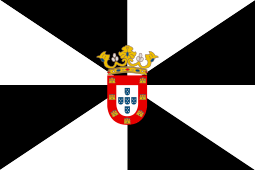Conquest of Ceuta
The conquest of Ceuta (Spanish pronunciation: [ˈθeuta]) by the Portuguese on 21 August 1415 marks an important step in the beginning of the Portuguese Empire in Africa.
History
Shortly after the conquest of the region by the Arabs from the Byzantine Empire, Ceuta served as a staging ground in the Umayyad conquest of Hispania in 711, but it was destroyed in 740 and only rebuilt in the 9th century, passing to the Caliphate of Córdoba in the 10th century. In the subsequent centuries it remained under the rule of the Almoravids and Almohads as well as various Andalusian Taifas. Prior to its capture by the Portuguese, Ceuta had seen a period of political instability in previous decades, under competing interests from the Marinid Empire and the Kingdom of Granada.[n. 1]
The attack on Ceuta also offered the younger nobility an opportunity to win wealth and glory. The chief promoter of the Ceuta expedition was João Afonso, royal overseer of finance. Ceuta's position opposite the straits of Gibraltar gave it control of one of the main outlets of the trans-African Sudanese gold trade; and it could enable Portugal to flank its most dangerous rival, Castile.[8]
The Portuguese fleet captained by King John I of Portugal left Tavira in the Algarve and held a Council of war, while anchored off Punta Carnero, Spain before carrying out the conquest of Ceuta.[9]
On the morning of 21 August 1415, John I of Portugal led his sons and their assembled forces in a surprise assault on Ceuta, landing on Playa San Amaro. The battle itself was almost anti-climactic, because the 45,000 men who traveled on 200 Portuguese ships caught the defenders of Ceuta off guard. By nightfall the town was captured. On the morning of 22 August, Ceuta was in Portuguese hands. Álvaro Vaz de Almada, 1st Count of Avranches was asked to hoist the flag of Ceuta, which is identical to the flag of Lisbon, but in which the coat of arms of the Kingdom of Portugal was added to the center, a symbol that still stands today. The fleet then returned to Tavira in the Algarve.
John's son Henry the Navigator distinguished himself in the battle, being wounded during the conquest. The looting of the city proved to be less profitable than expected for John I; he ultimately decided to keep the city, in order to pursue further enterprises in the area.[10]
Under King John's son, Duarte, the colony at Ceuta rapidly became a drain on the Portuguese treasury. Trans-Sahara caravans journeyed instead to Tangier. It was soon realised that without the city of Tangier, possession of Ceuta was worthless. In 1437, Duarte's brothers Henry and Ferdinand persuaded him to launch an attack on the Marinid sultanate. The resulting attack on Tangier, led by Henry, was a debacle. In the resulting treaty, Henry promised to deliver Ceuta back to the Marinids in return for allowing the Portuguese army to depart unmolested.
Possession of Ceuta would indirectly lead to further Portuguese expansion. The main area of Portuguese expansion, at this time, was the coast of Morocco, where there was grain, cattle, sugar, and textiles, as well as fish, hides, wax, and honey.[8]
Ceuta had to endure alone for 43 years, until the position of the city was consolidated with the taking of Ksar es-Seghir (1458), Arzila and Tangier (1471).
The city was recognized as a Portuguese possession by the Treaty of Alcáçovas (1479) and by the Treaty of Tordesilhas (1494).
Notes
- A Nasrid fleet sent by Abu Said Faraj, Governor of Málaga, had conquered Ceuta from the 'Azafids in May 1306;[6] later, in 1309, the city was taken by the Marinids with the support of an Aragonese fleet.[7]
References
- Newitt, p. 20
- Gallagher 2003, p. 38.
- Kinard, p. 44
- Koch, p. 36
- Chase, p. 109
- Latham 1973, pp. 116–117; Manzano Rodríguez 1992, pp. 160–162.
- Manzano Rodríguez 1992, p. 182.
- Payne, Stanley G., A History of Spain and Portugal, Vol. 1, Chap. 10 "The Expansion"
- Peter Russell, Prince Henry 'the Navigator' A life, Ed. Yale Nota Bene, 2001, pp. 47–48 ISBN 0300091303
- López de Coca Castañer 1998, p. 351.
References
- Latham, John Derek (1973). "The later 'Azafids". Revue de l'Occident musulman et de la Méditerranée. 15 (1): 109–125. ISSN 2105-2271.CS1 maint: ref=harv (link)
- López de Coca Castañer, José Enrique (1998). "Granada y la expansión portuguesa en el Magreb extremo". Historia. Instituciones. Documentos. Seville: Universidad de Sevilla (25): 351–368. ISSN 0210-7716.CS1 maint: ref=harv (link)
- Manzano Rodríguez, Miguel Ángel (1992). La intervención de los Benimerines en la Península Ibérica. Madrid: Consejo Superior de Investigaciones Científicas. ISBN 84-00-07220-0.CS1 maint: ref=harv (link)
- Malyn Newitt. A History of Portuguese Overseas Expansion 1400–1668 (2004) ISBN 9781134553044
- Kenneth Warren Chase. Firearms: a global history to 1700 (2003) ISBN 978-0-521-82274-9
- Gallagher, Aileen (2003). Prince Henry the Navigator: Pioneer of Modern Exploration. ISBN 978-0-8239-3621-2.CS1 maint: ref=harv (link)
- Jeff Kinard. Artillery: an illustrated history of its impact (2007) ISBN 978-1-85109-556-8
- Peter O. Koch, To the ends of the earth: the age of the European explorers (2003) ISBN 978-0-7864-1565-6
